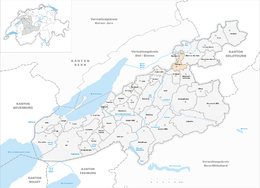Dotzigen
| Dotzigen | ||
|---|---|---|

Dotzigen Castle near the village
|
||
|
||
| Coordinates: 47°7′N 7°20′E / 47.117°N 7.333°ECoordinates: 47°7′N 7°20′E / 47.117°N 7.333°E | ||
| Country | Switzerland | |
| Canton | Bern | |
| District | Seeland | |
| Government | ||
| • Mayor |
Gemeindepräsident Hansruedi Witkowski (as of 2008) |
|
| Area | ||
| • Total | 4.22 km2 (1.63 sq mi) | |
| Elevation | 435 m (1,427 ft) | |
| Population (Dec 2015) | ||
| • Total | 1,455 | |
| • Density | 340/km2 (890/sq mi) | |
| Postal code | 3293 | |
| SFOS number | 0386 | |
| Surrounded by | Büetigen, Schwadernau, Scheuren, Meienried, Büren an der Aare and Diessbach bei Büren | |
| Website |
www SFSO statistics |
|
Dotzigen is a municipality in the Seeland administrative district in the canton of Bern in Switzerland.
Dotzigen is first mentioned in 1182 as Tocingen.
The earliest trace of settlements in Dotzigen are six Hallstatt grave mounds on the Dotzigenberg. This was followed by a Roman era settlement near the current village center. During the Middle Ages it was part of the Herrschaft of Strassberg, which was acquired in 1393 by Bern. It was part of the low court of Diesbach in the bailiwick of Büren.
The village church of St. Mauritius was first mentioned in 1242. After the Protestant Reformation, in 1531, it came under Bernese control and the parish was immediately dissolved. At first the village was part of the parish of Büren and then later of Diessbach.
The village was along the Büren-Aarberg road and the inhabitants traded produce to those towns and operated a rest station. The Jura water correction projects of the 19th century helped prevent flooding and destruction in the village. In 1876 the Solothurn-Lyss railroad connected the village to those larger cities. Easy transportation links allowed commercial and industrial developments in Dotzigen. A distillery opened in 1888, followed by a brick factory in 1891 and a Parketterie furniture factory in 1898. Despite the presence of an agricultural cooperative and a metal foundry, in 2000 over two-thirds of the labor force commuted to towns such as Biel, Lyss and Grenchen. The historic Schlössli outside the village was built in 1898 by the brick manufacturer Johann Schaller.
...
Wikipedia



